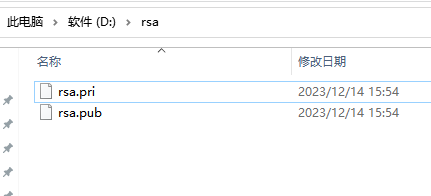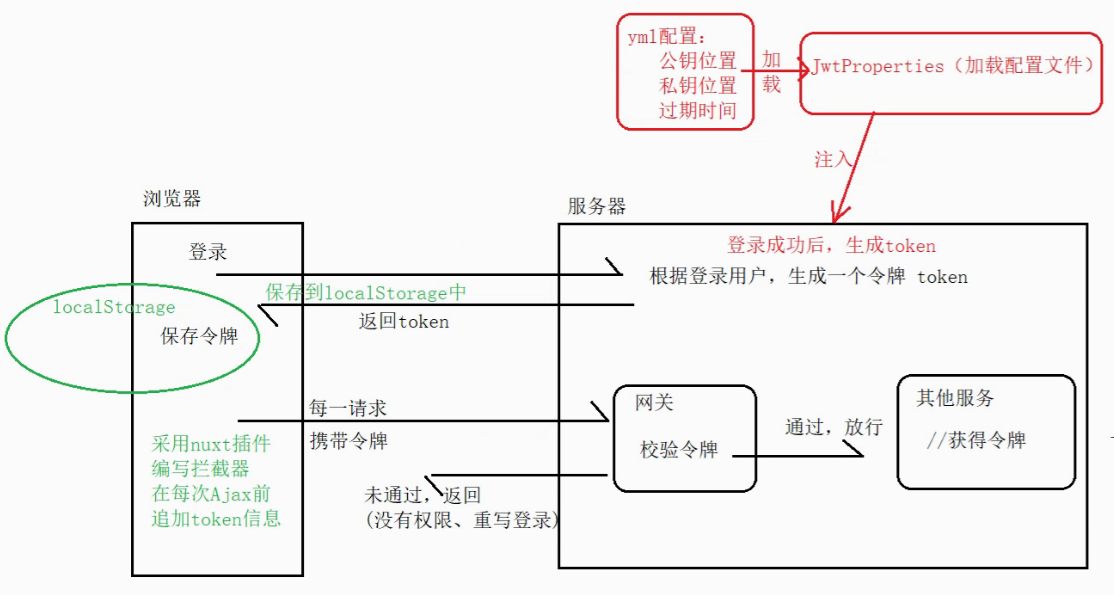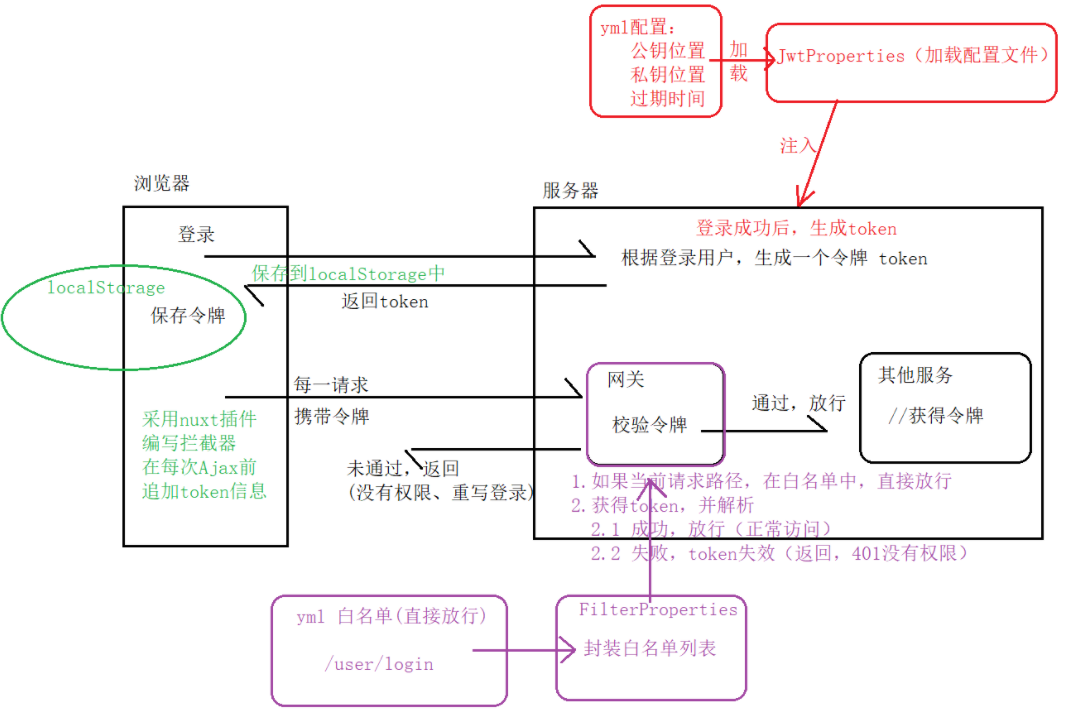后端:
- 环境搭建
-
- 父项目pom【重点在jwt工具】
<dependencyManagement>
<dependencies>
<!-- Spring Dependencies -->
<dependency>
<groupId>org.springframework.boot</groupId>
<artifactId>spring-boot-dependencies</artifactId>
<version>${spring-boot.version}</version>
<type>pom</type>
<scope>import</scope>
</dependency>
<dependency>
<groupId>org.springframework.cloud</groupId>
<artifactId>spring-cloud-dependencies</artifactId>
<version>${spring.cloud.version}</version>
<type>pom</type>
<scope>import</scope>
</dependency>
<dependency>
<groupId>com.alibaba.cloud</groupId>
<artifactId>spring-cloud-alibaba-dependencies</artifactId>
<version>${spring.cloud.alibaba.version}</version>
<type>pom</type>
<scope>import</scope>
</dependency>
<!-- mybatis-plus -->
<dependency>
<groupId>com.baomidou</groupId>
<artifactId>mybatis-plus-boot-starter</artifactId>
<version>${mybatis.plus.starter.version}</version>
</dependency>
<dependency>
<groupId>com.baomidou</groupId>
<artifactId>mybatis-plus-annotation</artifactId>
<version>${mybatis.plus.starter.version}</version>
</dependency>
<!-- Druid连接池 -->
<dependency>
<groupId>com.alibaba</groupId>
<artifactId>druid-spring-boot-starter</artifactId>
<version>${durid.starter.version}</version>
</dependency>
<!--swagger2-->
<dependency>
<groupId>io.springfox</groupId>
<artifactId>springfox-swagger2</artifactId>
<version>${swagger.version}</version>
</dependency>
<dependency>
<groupId>io.springfox</groupId>
<artifactId>springfox-swagger-ui</artifactId>
<version>${swagger.version}</version>
</dependency>
<!--jwt-->
<!--JavaBean工具类,用于JavaBean数据封装-->
<dependency>
<groupId>commons-beanutils</groupId>
<artifactId>commons-beanutils</artifactId>
<version>${beanutils.version}</version>
</dependency>
<!--jwt工具-->
<dependency>
<groupId>io.jsonwebtoken</groupId>
<artifactId>jjwt</artifactId>
<version>${jwt.jjwt.version}</version>
</dependency>
<!--joda 时间工具类 -->
<dependency>
<groupId>joda-time</groupId>
<artifactId>joda-time</artifactId>
<version>${jwt.joda.version}</version>
</dependency>
</dependencyManagement>-
- 网关pom
<dependencies>
<!-- 网关 -->
<dependency>
<groupId>org.springframework.cloud</groupId>
<artifactId>spring-cloud-starter-gateway</artifactId>
</dependency>
<!-- nacos 服务发现 -->
<dependency>
<groupId>com.alibaba.cloud</groupId>
<artifactId>spring-cloud-starter-alibaba-nacos-discovery</artifactId>
</dependency>
<!-- 测试 -->
<dependency>
<groupId>org.springframework.boot</groupId>
<artifactId>spring-boot-starter-test</artifactId>
</dependency>
<!--jwt-->
<!--JavaBean工具类,用于JavaBean数据封装-->
<dependency>
<groupId>commons-beanutils</groupId>
<artifactId>commons-beanutils</artifactId>
</dependency>
<!--jwt工具-->
<dependency>
<groupId>io.jsonwebtoken</groupId>
<artifactId>jjwt</artifactId>
</dependency>
<!--joda 时间工具类 -->
<dependency>
<groupId>joda-time</groupId>
<artifactId>joda-time</artifactId>
</dependency>
<!--自定义项目-->
<dependency>
<groupId>com.czxy</groupId>
<artifactId>nacos_student_doamin</artifactId>
<version>1.0-SNAPSHOT</version>
</dependency>
</dependencies>- 添加JWT和RSA工具类

JwtUtils:
package com.czxy.utils;
import io.jsonwebtoken.Claims;
import io.jsonwebtoken.JwtBuilder;
import io.jsonwebtoken.Jwts;
import io.jsonwebtoken.SignatureAlgorithm;
import org.apache.commons.beanutils.BeanUtils;
import org.joda.time.DateTime;
import java.beans.BeanInfo;
import java.beans.IntrospectionException;
import java.beans.Introspector;
import java.beans.PropertyDescriptor;
import java.lang.reflect.InvocationTargetException;
import java.security.PrivateKey;
import java.security.PublicKey;
public class JwtUtils {
/**
* 私钥加密token
* @param data 需要加密的数据(载荷内容)
* @param expireMinutes 过期时间,单位:分钟
* @param privateKey 私钥
* @return
*/
public static String generateToken(Object data, int expireMinutes, PrivateKey privateKey) {
try {
//1 获得jwt构建对象
JwtBuilder jwtBuilder = Jwts.builder();
//2 设置数据
if( data == null ) {
throw new RuntimeException("数据不能为空");
}
BeanInfo beanInfo = Introspector.getBeanInfo(data.getClass());
PropertyDescriptor[] propertyDescriptors = beanInfo.getPropertyDescriptors();
for (PropertyDescriptor propertyDescriptor : propertyDescriptors) {
// 获得属性名
String name = propertyDescriptor.getName();
// 获得属性值
Object value = propertyDescriptor.getReadMethod().invoke(data);
if(value != null) {
jwtBuilder.claim(name,value);
}
}
//3 设置过期时间
jwtBuilder.setExpiration(DateTime.now().plusMinutes(expireMinutes).toDate());
//4 设置加密
jwtBuilder.signWith(SignatureAlgorithm.RS256, privateKey);
//5 构建
return jwtBuilder.compact();
} catch (Exception e) {
throw new RuntimeException(e);
}
}
/**
* 通过公钥解析token
* @param token 需要解析的数据
* @param publicKey 公钥
* @param beanClass 封装的JavaBean
* @return
* @throws Exception
*/
public static <T> T getObjectFromToken(String token, PublicKey publicKey,Class<T> beanClass) throws Exception {
//1 获得解析后内容
Claims body = Jwts.parser().setSigningKey(publicKey).parseClaimsJws(token).getBody();
//2 将内容封装到对象JavaBean
T bean = beanClass.newInstance();
BeanInfo beanInfo = Introspector.getBeanInfo(beanClass);
PropertyDescriptor[] propertyDescriptors = beanInfo.getPropertyDescriptors();
for (PropertyDescriptor propertyDescriptor : propertyDescriptors) {
// 获得属性名
String name = propertyDescriptor.getName();
// 通过属性名,获得对应解析的数据
Object value = body.get(name);
if(value != null) {
// 将获得的数据封装到对应的JavaBean中
BeanUtils.setProperty(bean,name,value);
}
}
return bean;
}
}
RsaUtils:
package com.czxy.utils;
import java.io.File;
import java.io.IOException;
import java.nio.file.Files;
import java.security.*;
import java.security.spec.PKCS8EncodedKeySpec;
import java.security.spec.X509EncodedKeySpec;
public class RsaUtils {
/**
* 从文件中读取公钥
*
* @param filename 公钥保存路径,相对于classpath
* @return 公钥对象
* @throws Exception
*/
public static PublicKey getPublicKey(String filename) throws Exception {
byte[] bytes = readFile(filename);
return getPublicKey(bytes);
}
/**
* 从文件中读取密钥
*
* @param filename 私钥保存路径,相对于classpath
* @return 私钥对象
* @throws Exception
*/
public static PrivateKey getPrivateKey(String filename) throws Exception {
byte[] bytes = readFile(filename);
return getPrivateKey(bytes);
}
/**
* 获取公钥
*
* @param bytes 公钥的字节形式
* @return
* @throws Exception
*/
public static PublicKey getPublicKey(byte[] bytes) throws Exception {
X509EncodedKeySpec spec = new X509EncodedKeySpec(bytes);
KeyFactory factory = KeyFactory.getInstance("RSA");
return factory.generatePublic(spec);
}
/**
* 获取密钥
*
* @param bytes 私钥的字节形式
* @return
* @throws Exception
*/
public static PrivateKey getPrivateKey(byte[] bytes) throws Exception {
PKCS8EncodedKeySpec spec = new PKCS8EncodedKeySpec(bytes);
KeyFactory factory = KeyFactory.getInstance("RSA");
return factory.generatePrivate(spec);
}
/**
* 根据密文,生存rsa公钥和私钥,并写入指定文件
*
* @param publicKeyFilename 公钥文件路径
* @param privateKeyFilename 私钥文件路径
* @param secret 生成密钥的密文
* @throws Exception
*/
public static void generateKey(String publicKeyFilename, String privateKeyFilename, String secret) throws Exception {
KeyPairGenerator keyPairGenerator = KeyPairGenerator.getInstance("RSA");
SecureRandom secureRandom = new SecureRandom(secret.getBytes());
keyPairGenerator.initialize(1024, secureRandom);
KeyPair keyPair = keyPairGenerator.genKeyPair();
// 获取公钥并写出
byte[] publicKeyBytes = keyPair.getPublic().getEncoded();
writeFile(publicKeyFilename, publicKeyBytes);
// 获取私钥并写出
byte[] privateKeyBytes = keyPair.getPrivate().getEncoded();
writeFile(privateKeyFilename, privateKeyBytes);
}
private static byte[] readFile(String fileName) throws Exception {
return Files.readAllBytes(new File(fileName).toPath());
}
private static void writeFile(String destPath, byte[] bytes) throws IOException {
File dest = new File(destPath);
//创建父文件夹
if(!dest.getParentFile().exists()){
dest.getParentFile().mkdirs();
}
//创建需要的文件
if (!dest.exists()) {
dest.createNewFile();
}
Files.write(dest.toPath(), bytes);
}
}
- 使用Rsa工具类【生成公钥和私钥、获取公钥和私钥】
生成公钥和私钥
private static final String pubKeyPath = "D:\\rsa\\rsa.pub";
private static final String priKeyPath = "D:\\rsa\\rsa.pri";
/*
*生成公钥、私钥
* * @throws Exception */
@Test
public void testRsaGenerate() throws Exception {
RsaUtils.generateKey(pubKeyPath,priKeyPath,"1234");
}
获取公钥和私钥
/*
* 测试
* * @throws Exception*/
@Test
public void testGet() throws Exception {
PublicKey publicKey = RsaUtils.getPublicKey(pubKeyPath);
System.out.println(publicKey);
PrivateKey privateKey = RsaUtils.getPrivateKey(priKeyPath);
System.out.println(privateKey);
}
}
- 使用JWT工具类【生成token、解析token】
数据库:
CREATE TABLE `tb_user` (
`u_id` VARCHAR(32) PRIMARY KEY NOT NULL COMMENT '用户编号',
`user_name` VARCHAR(50) UNIQUE DEFAULT NULL COMMENT '用户名',
`password` VARCHAR(32) DEFAULT NULL COMMENT '密码',
`gender` BIT(1) DEFAULT NULL COMMENT '性别,1表示男,0表示女',
`image` VARCHAR(300) DEFAULT NULL COMMENT '头像图片'
);
INSERT INTO `tb_user`(`u_id`,`user_name`,`password`,`gender`,`image`) VALUES ('u001','jack','1234',1,'https://wpimg.wallstcn.com/f778738c-e4f8-4870-b634-56703b4acafe.gif?imageView2/1/w/80/h/80');
INSERT INTO `tb_user`(`u_id`,`user_name`,`password`,`gender`,`image`) VALUES ('u002','rose','1234',0,'https://wpimg.wallstcn.com/f778738c-e4f8-4870-b634-56703b4acafe.gif?imageView2/1/w/80/h/80');
INSERT INTO `tb_user`(`u_id`,`user_name`,`password`,`gender`,`image`) VALUES ('u003','tom','1234',1,'https://wpimg.wallstcn.com/f778738c-e4f8-4870-b634-56703b4acafe.gif?imageView2/1/w/80/h/80');创建User类:
@Data
@TableName(value = "tb_user")
public class User {
@TableId(value = "u_id")
private String uid;
@TableField(value = "user_name")
private String username;
private String password;
private Boolean gender;
private String image;
}生成token:
/**
* 生成token
* @throws Exception
* */
@Test
public void testCreateToken() throws Exception {
User user = new User();
user.setPassword("1234");
user.setUsername("xxx");
String token = JwtUtils.generateToken(user,30, RsaUtils.getPrivateKey(priKeyPath));
System.out.println(token);
}

解析token:
/**
* 解析token
* @throws Exception
* */
@Test
public void testParseToken() throws Exception {
String token = "eyJhbGciOiJSUzI1NiJ9.eyJjbGFzcyI6ImNvbS5jenh5LmRvbWFpbi5Vc2VyIiwicGFzc3dvcmQiOiIxMjM0IiwidXNlcm5hbWUiOiJ4eHgiLCJleHAiOjE3MDI1NjE4MTR9.XRIiTX1gi9RD2JiRLDSsnpTmPH9VbjfI9TKkL4_UBnWfBmzGZsVUVhpkVPxNJ3UTUyyFkpQ0CRgi0SYuwiUWM08TQhvMdhDfPpV_VRSjOrsgoVMywOT-8QU61Q-nlF03nXYwvbf_keJ8fGBHfadBVowNvGmB0dGWstJsXefVwOQ";
User user = JwtUtils.getObjectFromToken(token, RsaUtils.getPublicKey(pubKeyPath), User.class);
System.out.println(user);
}
上方都是在测试JWT和RSA工具类
整合登录:【前后端】***

后端登录服务:生成token
- 用户服务JWT环境
<dependencies>
<!--web起步依赖-->
<dependency>
<groupId>org.springframework.boot</groupId>
<artifactId>spring-boot-starter-web</artifactId>
</dependency>
<!-- nacos 服务发现 -->
<dependency>
<groupId>com.alibaba.cloud</groupId>
<artifactId>spring-cloud-starter-alibaba-nacos-discovery</artifactId>
</dependency>
<!--swagger2-->
<dependency>
<groupId>io.springfox</groupId>
<artifactId>springfox-swagger2</artifactId>
</dependency>
<dependency>
<groupId>io.springfox</groupId>
<artifactId>springfox-swagger-ui</artifactId>
</dependency>
<!-- feign 远程调用 -->
<dependency>
<groupId>org.springframework.cloud</groupId>
<artifactId>spring-cloud-starter-openfeign</artifactId>
</dependency>
<!--测试-->
<dependency>
<groupId>org.springframework.boot</groupId>
<artifactId>spring-boot-starter-test</artifactId>
</dependency>
<!-- mybatis plus-->
<dependency>
<groupId>com.baomidou</groupId>
<artifactId>mybatis-plus-boot-starter</artifactId>
</dependency>
<!-- mysql驱动 -->
<dependency>
<groupId>mysql</groupId>
<artifactId>mysql-connector-java</artifactId>
</dependency>
<!--jwt-->
<!--JavaBean工具类,用于JavaBean数据封装-->
<dependency>
<groupId>commons-beanutils</groupId>
<artifactId>commons-beanutils</artifactId>
</dependency>
<!--jwt工具-->
<dependency>
<groupId>io.jsonwebtoken</groupId>
<artifactId>jjwt</artifactId>
</dependency>
<!--joda 时间工具类 -->
<dependency>
<groupId>joda-time</groupId>
<artifactId>joda-time</artifactId>
</dependency>
</dependencies>- 粘贴上方工具类
- 配置yml文件
#自定义内容
sc:
jwt:
secret: sc@Login(Auth}*^31)&czxy% # 登录校验的密钥(自定义内容)
pubKeyPath: D:/rsa/rsa.pub # 公钥地址
priKeyPath: D:/rsa/rsa.pri # 私钥地址
expire: 360 # 过期时间,单位分钟- 创建JwtProperties配置类
package com.czxy.config;
import com.czxy.utils.RsaUtils;
import lombok.Data;
import org.springframework.boot.context.properties.ConfigurationProperties;
import org.springframework.stereotype.Component;
import javax.annotation.PostConstruct;
import java.io.File;
import java.security.PrivateKey;
import java.security.PublicKey;
@Data
@ConfigurationProperties(prefix = "sc.jwt")
@Component
public class JwtProperties {
private String secret; // 密钥
private String pubKeyPath;// 公钥
private String priKeyPath;// 私钥
private int expire;// token过期时间
private PublicKey publicKey; // 公钥
private PrivateKey privateKey; // 私钥
@PostConstruct //当前类加载到spring容器时,执行(初始化操作)
public void init(){
try {
File pubFile = new File(this.pubKeyPath);
File priFile = new File(this.priKeyPath);
//如果公钥或私钥文件不存在,则自动生成公钥私钥文件
if( !pubFile.exists() || !priFile.exists()){
RsaUtils.generateKey( this.pubKeyPath ,this.priKeyPath , this.secret);
}
//根据公钥或私钥路径,生成对应的对象
this.publicKey = RsaUtils.getPublicKey( this.pubKeyPath );
this.privateKey = RsaUtils.getPrivateKey( this.priKeyPath );
} catch (Exception e) {
e.printStackTrace();
}
}
}
- 在controller中生成token
package com.czxy.controller;
import com.baomidou.mybatisplus.core.conditions.query.QueryWrapper;
import com.czxy.config.JwtProperties;
import com.czxy.domain.User;
import com.czxy.service.UserService;
import com.czxy.utils.JwtUtils;
import com.czxy.vo.BaseResult;
import org.springframework.web.bind.annotation.PostMapping;
import org.springframework.web.bind.annotation.RequestBody;
import org.springframework.web.bind.annotation.RequestMapping;
import org.springframework.web.bind.annotation.RestController;
import javax.annotation.Resource;
@RestController
@RequestMapping("/user")
public class UserController {
@Resource
private UserService userService;
@Resource
private JwtProperties jwtProperties;
/*
* 登录
* */
@PostMapping("/login")
public BaseResult<User> login(@RequestBody User user){
// 1. 登录
User login = userService.login(user);
// 2. 处理结果
if (login!= null){
// 生成token
String token = JwtUtils.generateToken(user, jwtProperties.getExpire(), jwtProperties.getPrivateKey());
return BaseResult.ok("登陆成功").append("login", login).append("token", token);
}else {
return BaseResult.error("用户名或密码错误");
}
}
/*
* 用户校验
* */
@PostMapping("/checkUsername")
public BaseResult<String> checkUsername(@RequestBody User user){
// 1. 校验
QueryWrapper<User> queryWrapper = new QueryWrapper<>();
queryWrapper.eq("user_name", user.getUsername());
User check = userService.getOne(queryWrapper);
// 2. 处理结果
if(check != null) {
return BaseResult.ok("允许登录");
}else {
return BaseResult.error("用户名不存在!");
}
}
}
{ "code": 20000, "message": "登录成功", "data": null, "other": { "login": { "uid": "u001", "username": "jack", "password": "1234", "gender": true, "image": "https://wpimg.wallstcn.com/f778738c-e4f8-4870-b634-56703b4acafe.gif?imageView2/1/w/80/h/80" }, "token": "eyJhbGciOiJSUzI1NiJ9.eyJjbGFzcyI6ImNvbS5jenh5LmRvbWFpbi5Vc2VyIiwicGFzc3dvcmQiOiIxMjM0IiwidXNlcm5hbWUiOiJqYWNrIiwiZXhwIjoxNzAyNTY2NTM5fQ.JNANysq-NGKnn-NGbV7i7PXF4OPnDamgf-30j2tsnFIVDT_CkLwJL006o96ic1rFBHaTK-9Y7iWlOt0-9oBvDeBnOrwEErT6GdkKQZs3NxDMUs9h-nS__jaDC11JEtbxPE8H204ggIRZjYHxST-K_cfQ-xLKW2zuvcT3qXgUYgc" }
前端保存/携带token
- 保存:登录成功后,保存到localStorage中
- 携带:每次Ajax前,都追加token。需要对axios进行增强,底层需要编写axios的请求拦截器。
-
- 最终采用nuxt的插件对axios进行增强
- 参考文献:

- 浏览器保存token
在登录方法中添加一段代码
// 将token保存到浏览器端
localStorage.setItem("token", (login.other.token)登录方法完整版:
// 登录
login() {
this.$refs["ruleFrom"].validate(async (valid) => {
if (valid) {
// 校验通过start
let { data: login } = await this.$axios.post(`/user-service/user/login`, this.user)
if (login.code == 20000) {
this.$message.success(login.message)
// 将登录用户信息,保存到浏览器端(关闭浏览器后仍会保存)
localStorage.setItem("login", JSON.stringify(login.other.login))
// 将token保存到浏览器端
localStorage.setItem("token", login.other.token)
this.$router.push("/") // 路由跳转到首页
// location.href = "/" // 支持服务端渲染
} else {
this.$message.error(login.message)
}
// 校验通过end
} else {
// 校验失败
console.log('error submit!!');
return false;
}
});
}- 在nuxt.config.js中配置【nuxt插件】
export default {
plugins: [
{ src: '~/plugins/both-sides.js' }, // 客户端 或 服务器端 运行
{ src: '~/plugins/client-only.js', mode: 'client' }, // 客户端运行
{ src: '~/plugins/server-only.js', mode: 'server' } // 服务端运行
]
}这里只需要在客户端运行就可,修改代码如下:
plugins: [
{ src: '~/plugins/axios.js', mode: 'client' },
],- 在plugins文件夹中创建axios.js文件

- 实现Ajax请求前获取token
export default function ({ $axios, redirect }) {
$axios.onRequest(config => {
console.log('Making request to ' + config.url)
// 获取token
let token = localStorage.getItem("token")
// 携带token
$axios.setToken(token)
})
$axios.onError(error => {
const code = parseInt(error.response && error.response.status)
if (code === 400) {
redirect('/400')
}
})
}

网关校验token

- 检查环境 网关pom【jwt】已配置
<dependencies>
<!-- 网关 -->
<dependency>
<groupId>org.springframework.cloud</groupId>
<artifactId>spring-cloud-starter-gateway</artifactId>
</dependency>
<!-- nacos 服务发现 -->
<dependency>
<groupId>com.alibaba.cloud</groupId>
<artifactId>spring-cloud-starter-alibaba-nacos-discovery</artifactId>
</dependency>
<!-- 测试 -->
<dependency>
<groupId>org.springframework.boot</groupId>
<artifactId>spring-boot-starter-test</artifactId>
</dependency>
<!--jwt-->
<!--JavaBean工具类,用于JavaBean数据封装-->
<dependency>
<groupId>commons-beanutils</groupId>
<artifactId>commons-beanutils</artifactId>
</dependency>
<!--jwt工具-->
<dependency>
<groupId>io.jsonwebtoken</groupId>
<artifactId>jjwt</artifactId>
</dependency>
<!--joda 时间工具类 -->
<dependency>
<groupId>joda-time</groupId>
<artifactId>joda-time</artifactId>
</dependency>
<!--自定义项目-->
<!-- <dependency>
<groupId>com.czxy</groupId>
<artifactId>nacos_student_doamin</artifactId>
<version>1.0-SNAPSHOT</version>
</dependency> -->
</dependencies>- 配置yml(白名单)
#自定义内容
sc:
jwt:
secret: sc@Login(Auth}*^31)&czxy% # 登录校验的密钥(自定义内容)
pubKeyPath: D:/rsa/rsa.pub # 公钥地址
priKeyPath: D:/rsa/rsa.pri # 私钥地址
expire: 360 # 过期时间,单位分钟
filter:
allowPaths:
- /user/login
- /user/checkUsername
- /user/register
- /classes- 配置config工具类

JwtProperties类上方已有
FilterProperties:【获得白名单】
package com.czxy.config;
import lombok.Data;
import org.springframework.boot.context.properties.ConfigurationProperties;
import java.util.List;
@Data
@ConfigurationProperties(prefix = "sc.filter")
public class FilterProperties {
private List<String> allowPaths;
}- 网关过滤器
拷贝
package com.czxy.filter;
import com.czxy.config.FilterProperties;
import com.czxy.config.JwtProperties;
import com.czxy.domain.User;
import com.czxy.utils.JwtUtils;
import org.springframework.boot.context.properties.EnableConfigurationProperties;
import org.springframework.cloud.gateway.filter.GatewayFilterChain;
import org.springframework.cloud.gateway.filter.GlobalFilter;
import org.springframework.core.Ordered;
import org.springframework.core.io.buffer.DataBuffer;
import org.springframework.http.HttpStatus;
import org.springframework.http.server.reactive.ServerHttpResponse;
import org.springframework.stereotype.Component;
import org.springframework.web.server.ServerWebExchange;
import reactor.core.publisher.Flux;
import reactor.core.publisher.Mono;
import javax.annotation.Resource;
import java.nio.charset.StandardCharsets;
import java.util.List;
@Component
@EnableConfigurationProperties({FilterProperties.class})
public class LoginFilter implements GlobalFilter, Ordered {
@Resource
private FilterProperties filterProperties;
@Resource
private JwtProperties jwtProperties;
@Override
public Mono<Void> filter(ServerWebExchange exchange, GatewayFilterChain chain) {
// 1. 获取请求路径
String path = exchange.getRequest().getURI().getPath();;
System.out.println("请求路径:" + path);
// 2. 白名单
List<String> allowPaths = filterProperties.getAllowPaths();
for(String allowPath : allowPaths) {
// 请求路径中包含放行的路径
if(path.contains(allowPath)) {
return chain.filter(exchange); // 放行
}
}
// 3. 校验token
// 3.1 获取token Authorization
String token = exchange.getRequest().getHeaders().getFirst("Authorization");
System.out.println(token);
try {
// 3.2 校验token,解析成功
JwtUtils.getObjectFromToken(token,jwtProperties.getPublicKey(), User.class);
return chain.filter(exchange); // 放行
}catch (Exception e) {
// 3.3 处理失败结果
ServerHttpResponse response = exchange.getResponse(); // 获取响应对象
response.setStatusCode(HttpStatus.UNAUTHORIZED); // 设置状态码
response.getHeaders().add("Content-Type","application/json;charset=UTF-8"); // 设置响应头
DataBuffer wrap = response.bufferFactory().wrap("没有权限".getBytes(StandardCharsets.UTF_8)); // 包装响应数据
return exchange.getResponse().writeWith(Flux.just(wrap)); // 返回响应数据
}
}
@Override
public int getOrder() {
return 0;
}
}
- 校验失败前端处理
// 导入element-ui的提示框
import { MessageBox, Message } from 'element-ui'
$axios.onError(error => {
// 获取状态码
const code = parseInt(error.response && error.response.status)
// 如果状态码为400 ,跳转到“/400”页面
if (code === 400) {
redirect('/400')
}
// 如果状态码为401,提示没有权限,并跳转到登录页
if (code === 401) {
// 删除无效的token
localStorage.removeItem("token")
// 提示
MessageBox.confirm(error.response.data, '提示', {
confirmButtonText: '确定',
cancelButtonText: '取消',
type: 'warning'
}).then(() => {
// 确定
redirect("/user/login")
}).catch(() => {
Message.warning("已取消")
});
}
})
}





















 906
906











 被折叠的 条评论
为什么被折叠?
被折叠的 条评论
为什么被折叠?








